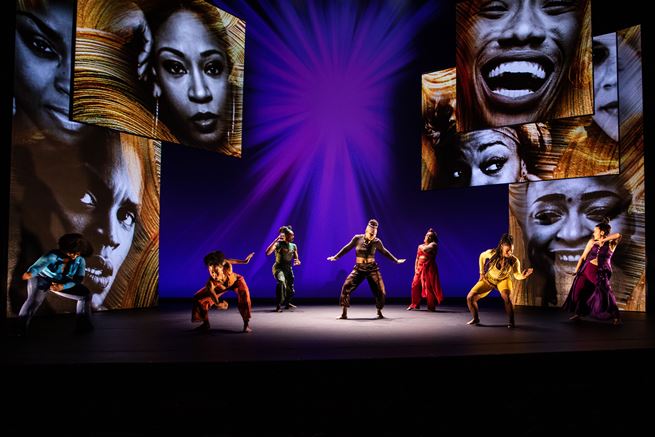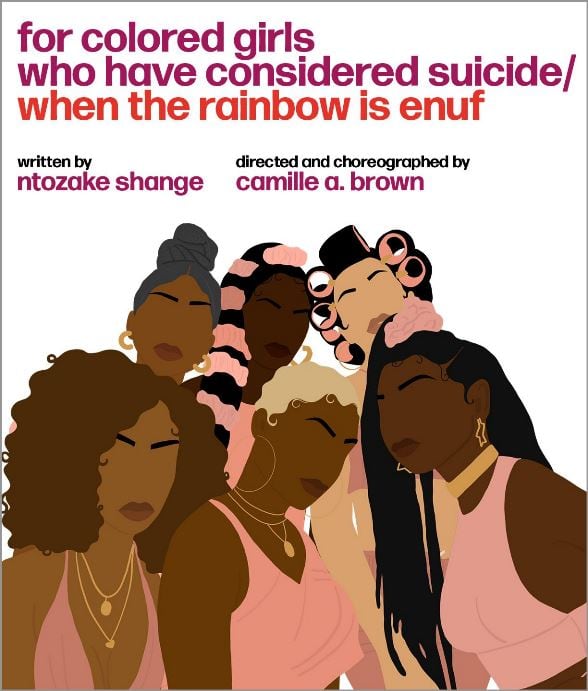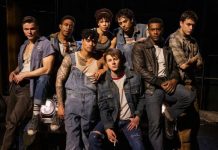Last seen in NYC in 2019, in the Off-Broadway revival of poet/playwright Ntozake Shange’s groundbreaking genre-defying “choreopoem” at The Public Theater (where it was first presented in 1976, and was honored with a 1977 Obie Award for Distinguished Production), for colored girls who have considered suicide/when the rainbow is enuf has returned to the Booth Theatre four decades after its pioneering Broadway premiere there – the second play ever by a Black woman to reach the Broadway stage – for a limited engagement through May 22.

The work’s radically inventive format and under-represented perspective fuses spoken word, poetry, music, dance, and song in a nonlinear sequence of short segments (30 here) featuring seven women of color – symbolically identified not by their first and last names, but as the seven beautiful colors of the rainbow – sharing their personal memories, attitudes, and experiences of racial and sexual oppression, while finding strength, self-empowerment, and sisterhood in the joyful celebration of their resilience, survival, camaraderie, and support of one another.
Fluidly directed and expressively choreographed by the masterful Camille A. Brown (who also choreographed the recent production at The Public), the stories – presented as an array of direct-address monologues and free verse, narrations and re-enactments, dialogues and rounds – are at once natural and colloquial, eloquent and poetic. The profoundly affecting language and perfectly attuned interpretive movements (that start off individualized then become increasingly synchronized as the women join together and acknowledge the commonality of their struggles) are filled with a range of emotions, from pleasure and pain to humor and outrage, and, above all, empathy, which resonates throughout the stage to the hearts, minds, and souls of the audience.
Each of the characters is portrayed with a unique personality, distinct likability, and unfailing humanity by a superb cast (which included three top-notch understudies on the date I attended) – Kenita R. Miller as the Lady in Red, McKenzie Frye (filling in for Amara Granderson) as the Lady in Orange, D. Woods as the Lady in Yellow, Alexis Sims (a standby for Okwui Okpokwasili) as the Lady in Green, Stacey Sargeant as the Lady in Blue, Treshelle Edmond (in for Alexandria Wailes) as the Lady in Purple, and Tendayi Kuumba as the Lady in Brown.

As an ensemble, they transition seamlessly from scene to scene, openly and honestly revealing everything from childhood games and first sexual encounters to date rape, unwanted pregnancy and abortion, to male infidelity, abandonment, and domestic abuse. They also capture the raw emotions those events engendered, along with the triumph of moving on and the joy of being part of a vital uplifting community of women who understand and relate.
Among the highlights of the consistently riveting production is the seductive dancing of Woods, the alternating use of signing, speaking, and motion by Edmond (who is deaf), Sims’ hilarious and self-confident delivery of “somebody almost walked off wid alla my stuff” (bringing laughs with the line “stealin my shit from me/dont make it yrs/makes it stolen”), and an intensely harrowing account by Miller of a woman desperately trying to save her two young children from the threat of their violent father, which elicited gasps and tears from the house.
The electrifying performances and physicality of Brown’s choreography – presented on a bare stage with large projection screens at both sides (scenic design by Myung Hee Cho) – are set to original music, orchestrations, and arrangements by Martha Redbone and Aaron Whitby, drum arrangements by Jaylen Petinaud (with Deah Love Harriot serving as music director and Tia Allen as music coordinator), and sound Justin Ellington, all of which suit the stories and emotions. And the eponymous theme (inspired by Shange’s life-affirming drive through a double rainbow after four suicide attempts) is referenced in the colorful lighting by Jiyoun Chang, projections by Aaron Rhyne, and costumes by Sarafina Bush in the seven different hues for which these glorious “colored girls” are named.
What was a revolutionary work of theater in the 1970s, remains a powerful expression of Shange’s voice of feminism and Black power; it’s a momentous piece that, like her characters, should be seen and heard.
Running Time: Approximately 90 minutes, without intermission.
for colored girls who have considered suicide/when the rainbow is enuf plays through Sunday, May 22, 2022, at the Booth Theatre, 222 West 45th Street, NYC. For tickets (priced at $49-225), call (212) 239-6200, or go online. Everyone must show proof of COVID-19 vaccination and a photo ID to enter the building and must wear a mask at all times when inside.






It was just announced that the production will close on Sunday, May 22, three months ahead of its originally scheduled closing date of August 14.